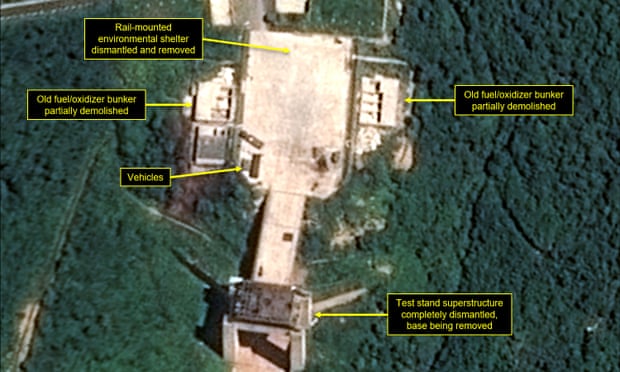
https://www.theguardian.com/world/2...dismantling-of-missile-test-facilities-reportSatellite images indicate North Korea has begun dismantling key facilities at a site used to develop engines for ballistic missiles, in a first step toward fulfilling a pledge made to US President Donald Trump at a June summit, reports a Washington-based think tank.
The images from 20 July showed work at the Sohae satellite launching station to dismantle a building used to assemble space-launch vehicles and a nearby rocket engine test stand used to develop liquid-fuel engines for ballistic missiles and space-launch vehicles, the 38 North think tank said.
https://www.reuters.com/article/us-...-facilities-at-test-site-report-idUSKBN1KD2HW“Since these facilities are believed to have played an important role in the development of technologies for the North’s intercontinental ballistic missile program, these efforts represent a significant confidence-building measure on the part of North Korea,” it said in a report.
Trump said after his unprecedented June 12 summit with North Korean leader Kim Jong Un in Singapore Kim had promised that a major missile engine testing site would be destroyed very soon.
Trump did not identify the site, but a U.S. official subsequently told Reuters that it was Sohae.
An official said on Tuesday South Korea’s presidential Blue House was briefed about the site’s dismantlement based on government intelligence but did not elaborate.
According to Yonhap, Nam Gwan-pyo, deputy director of the South’s national security office, said: “It’s better than doing nothing.”
“And it seems like they are going step by step toward denuclearization,” Nam said.
https://www.theguardian.com/world/2018/jul/20/north-korea-mike-pompeo-russia-china-oil-sanctionsThe US has urged Russia and China to clamp down on repeated breaches of the oil sanctions regime imposed on North Korea, saying America had evidence of at least 89 illegal ship-to-ship oil transfers this year.
Mike Pompeo, the US secretary of state, was speaking at the UN headquarters in New York on Friday, the day after Russia and China at the UN sanctions committee rejected a US call to step up sanctions saying it needed further evidence of North Korean sanctions evasion.
The Russian and Chinese decision at the UN was the first fissure in the international alliance putting pressure on Pyongyang to act on its commitment to end its efforts to become a nuclear power and effectively delayed further discussions on extra sanctions for as long as six months.
The US claims on the basis of intelligence that North Korea using ship-to-ship transfers in international waters has breached a cap of 500,000 barrels of refined oil a year – imposed by the security council in December. The US had demanded an immediate halt to all further oil transfers. “Strict enforcement of sanctions” was critical to achieving the goal of North Korea’s denuclearisation, Pompeo said.
Viimeksi muokattu:
